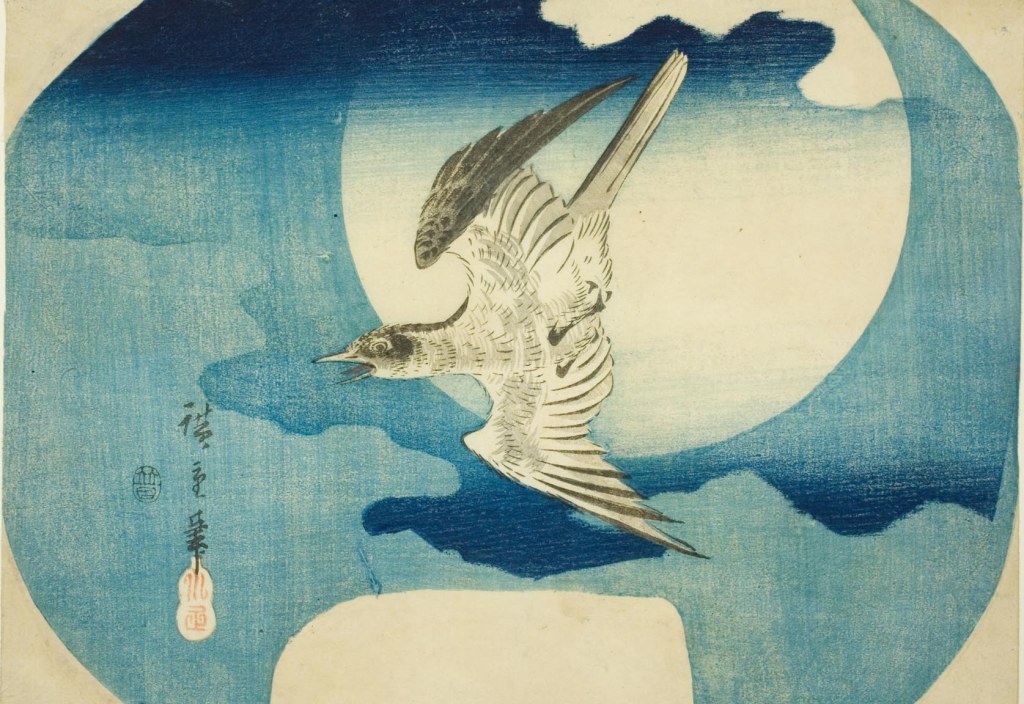“Where does Du Fu live?” travelers often asked of the reclusive Chinese poet.
And locals replied, “Down by the riverbank, underneath old Nanmu.”
The 17th century Japanese haiku poet Matuso Basho had his Basho, the weakly banana tree; the 8th century Chinese poet Du Fu, Nanmu, a tall stately conifer.
The Storm
In 759, in the midst of the devastating An Lushan Rebellion, the Chinese poet Du Fu moved to Chengdu. He stayed there in relative safety for four years, quietly writing poetry waiting for the storm to pass. For Du Fu, the Nanmu tree in front of his thatched cottage was a refuge in the broader political struggle between the Tang dynasty and rebelling troops who were primarily foreigners. The Dragon mentioned in the poem was the imperial symbol of the Tang Dynasty. The tiger, the rebels.
Following this is Matsuo Basho’s haiku about rain dripping in pots during a thunderstorm.
My Nanmu Uprooted by the Storm and Sighing
Du Fu, ca. 759-763
My Nanmu leaned on the river bank, in front of my thatched cottage,
An age old legend says that it’s two hundred years old.
It was foretold its thatch should cover my home,
In May one could already hear the cicadas warning.
When a southeast wind came and violently shook the land,
The river churned, stones tossed, among gusts of flowing clouds.
But my tree held back the thunderstorm in a battle of strength,
Is it heaven’s mandate to choose to cut the roots?
In a dismal storm an old tree is the best place to be,
Underneath thick foliage of an evergreen tree.
Passing travelers lingered here, afraid of snow and frost,
And those who walked came to listen to the music in its branches.
As the tiger falls to the dragon, cast into a thorny patch,
Tracks of tears and drops of blood fall onto my chest.
Where shall I go to sing my poems?
From this point on, my thatched cottage lacks all color.
Notes. The pine tree is a symbol of perseverance in winter and longevity. But what happens when a storm fells a tree? The cicada was a symbol of Du Fu’s simple, humble lifestyle. Tianyi, heaven’s mandate, fate. The wind blowing through the pine needles was a familiar Chinese metaphor for nature making its own music. For the meteorologically inclined: a southeast wind could mean both a wind that is out of the southeast and one that is southeast in direction. The An Lushan Rebellion began in the northwest and came south. “Feng” winds (Du Fu uses the term piaofeng, a whirlwind) were associated with violent, erratic, and disruptive storms.
Other Sources. A comprehensive collection of Du Fu’s poetry is found online in PDF format.. Search Du Fu and Steve Owens. Owens’ work complements another work by Xiaofei Tian, Du Fu quanji jiaozhu 杜甫全集校注, which is also available online in PDF format.
柟樹為風雨所拔歎
倚江柟樹草堂前,
古老相傳二百年。
誅茅卜居總為此,
五月髣髴聞寒蟬。
東南飄風動地至,
江翻石走流雲氣。
幹排雷雨猶力爭,
根斷泉源豈天意。
蒼波老樹性所愛,
浦上童童一青蓋。
野客頻留懼雪霜,
行人不過聽竽籟。
虎倒龍顛委榛棘,
淚痕血點垂胸臆。
我有新詩何處吟,
草堂自此無顏色。
Here is Matsuo Basho’s haiku about the banana tree outside his cottage in an autumn storm.
Banana tree in a fierce autumn gale
I wonder if I can hear
Rain in the tub, tonight!Bashō nowaki shite
Tarai ni ame o
Kiku yo kana芭蕉 野分 して盥に雨を聞く夜哉
Matsuo Basho, Autumn 1691
For more about Matsuo Basho, click here.








